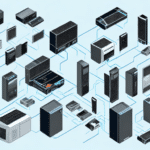Understanding UPS Fundamentals for Corrugate Suppliers
In the corrugate industry, a Uninterruptible Power Supply (UPS) is essential for maintaining continuous operations and protecting sensitive equipment from power disturbances. A UPS provides backup power during outages, voltage drops, and electrical surges, ensuring that production lines remain operational and data integrity is maintained.
What is a UPS?
A UPS is a device that ensures a seamless power supply by switching to battery power when it detects an interruption in the main power source. It consists of a battery system and an inverter that converts direct current (DC) from the battery into alternating current (AC) to power connected equipment.
Types of UPS Systems
- Offline/Standby UPS: Provides basic protection by switching to battery power during outages.
- Line-Interactive UPS: Offers voltage regulation and can handle brownouts and overvoltages without switching to battery.
- Online UPS: Provides continuous power conditioning and is ideal for sensitive and critical equipment.
Selecting the Ideal UPS for Your Corrugate Business
Choosing the right UPS involves assessing your power requirements and understanding the specific needs of your operations. Here are key factors to consider:
Power Capacity and Scalability
Determine the total power consumption of all equipment you intend to connect to the UPS. It's advisable to select a UPS with a capacity that exceeds your current needs to accommodate future expansion. For example, a small corrugate supplier might require a UPS with a capacity of around 10 kVA, while larger operations might need upwards of 100 kVA.
Runtime Considerations
Evaluate how long the UPS needs to sustain operations during an outage. Industry standards suggest a minimum of 10-15 minutes of backup power to allow for orderly shutdowns or switching to alternative power sources. Longer runtimes may be necessary for critical processes.
Compatibility and Integration
Ensure that the UPS is compatible with your existing power infrastructure, including input voltage and frequency. Additionally, consider the physical footprint of the UPS and its integration with your facility's layout.
Connecting and Configuring Your UPS for Optimal Performance
Proper installation and configuration are crucial for maximizing the effectiveness of your UPS system.
Installation Best Practices
- Correct Placement: Install the UPS in a cool, dry area away from direct sunlight and sources of heat.
- Proper Grounding: Ensure the UPS is properly grounded to prevent electrical hazards.
- Adequate Ventilation: Maintain sufficient airflow around the UPS to avoid overheating.
Connecting Equipment
When connecting equipment to the UPS:
- Identify and prioritize critical equipment that must remain operational during power disruptions.
- Use appropriate power cords and ensure all connections are secure.
- Regularly inspect cables and connectors for wear and damage.
Configuration and Monitoring
Utilize the UPS’s configuration settings and management software to:
- Set shutdown parameters and notifications.
- Monitor battery health and overall system performance.
- Integrate with building management systems for centralized control.
For more detailed guidance, refer to industry standards such as the International Electrotechnical Commission (IEC) guidelines.
Optimizing and Maintaining Your UPS for Efficiency and Longevity
Regular optimization and maintenance can significantly extend the lifespan of your UPS and ensure it performs efficiently.
Battery Management
The battery is a critical component of a UPS. Consider the following:
- Battery Type: Lithium-ion batteries offer higher efficiency and longer life compared to traditional lead-acid batteries.
- Regular Testing: Perform routine tests to check battery health and replace batteries as needed.
Energy Efficiency
Implement energy-saving features such as:
- Auto-Sleep Modes: Reduce power consumption during periods of low demand.
- Load Management: Distribute the power load effectively to avoid overburdening the UPS.
Maintenance Protocols
Establish a maintenance schedule that includes:
- Regular visual inspections for signs of wear or damage.
- Cleaning vents and components to prevent dust accumulation.
- Firmware updates to ensure the UPS operates with the latest enhancements and security features.
Power Protection Strategies and Backup Systems
Implementing comprehensive power protection strategies safeguards your corrugate operations from unforeseen power issues.
Surge Protection
Use surge protectors to shield equipment from voltage spikes. According to the Citorg, surge protectors can prevent damage to electronic components by absorbing excess voltage.
Generators as Backup Power
For prolonged outages, generators provide an additional layer of backup power. Ensure that generators are regularly maintained and have sufficient fuel supply:
- Choose generators with adequate capacity to support critical systems.
- Test generators periodically to verify operational readiness.
Power Conditioning
Implement power conditioners to enhance the quality of the electrical supply by filtering out noise and harmonics, as recommended by the EC&M.
Managing Your UPS for Sustainable Operations
Effective UPS management ensures long-term reliability and sustainability of your power protection systems.
Monitoring and Reporting
Utilize UPS management software to:
- Track real-time performance metrics.
- Generate reports for maintenance and audit purposes.
- Set up alerts for potential issues.
Training and Protocols
Ensure that all relevant personnel are trained in UPS operation and emergency protocols:
- Conduct regular training sessions on UPS management.
- Establish clear procedures for responding to power outages.
Compliance with Industry Standards
Adhere to standards set by organizations such as the National Fire Protection Association (NFPA) to ensure safety and reliability.
Future Trends in UPS Technology for Corrugate Suppliers
The UPS industry is advancing with innovations that enhance efficiency, sustainability, and integration capabilities.
Advancements in Battery Technology
Emerging battery technologies, such as solid-state and lithium-ion batteries, offer improved energy density and longer lifespans. These advancements contribute to more reliable and eco-friendly UPS systems.
Integration with Smart Systems
Smart UPS systems leverage Internet of Things (IoT) technology to enable:
- Remote monitoring and management.
- Predictive maintenance through data analytics.
- Automated responses to power fluctuations.
Artificial Intelligence and Machine Learning
AI and machine learning algorithms are being integrated into UPS systems to:
- Optimize energy usage based on predictive models.
- Enhance fault detection and diagnosis.
- Improve overall system resilience.
Staying informed about these trends can help corrugate suppliers invest in UPS technologies that not only meet current needs but also adapt to future demands.






















